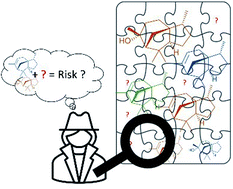Fate-directed risk assessment of chemical mixtures: a case study for cedarwood essential oil†
Abstract
The environmental risk assessment of UVCBs (i.e., substances of unknown or variable composition, complex reaction products, or biological materials) is challenging due to their inherent complexity. A particular problem is that UVCBs can contain constituents with unidentified chemical structures and/or have variable composition of constituents from batch to batch. Moreover, the composition of a UVCB in the environment is not the same as that of the UVCB in a product, meaning that a risk assessment based on environmental exposure to the UVCB in a product does not represent the actual environmental risk. Here we propose an in silico fate-directed risk assessment framework for UVCBs using cedarwood oil as a case study. The framework uses Monte Carlo simulations and the mass-balance models SimpleTreat and RAIDAR to provide quantitative information on whether unidentified constituents within the physical–chemical property space of a UVCB can be the decisive factor for the environmental risk of the entire UVCB. Thereby the framework provides a robust decision tool to evaluate if a UVCB risk assessment requires additional tests or if the data on known constituents is representative for the risk of the entire UVCB. In the case of cedarwood oil, it could be shown that a risk assessment based on the known constituents (representing around 70% of the overall UVCB by weight) is representative for the environmental risk of the entire UVCB – reducing the need for additional testing and test animals.

- This article is part of the themed collections: Recent Open Access Articles, Environmental exposure and impacts and Environmental Science: Processes & Impacts Recent HOT Articles


 Please wait while we load your content...
Please wait while we load your content...